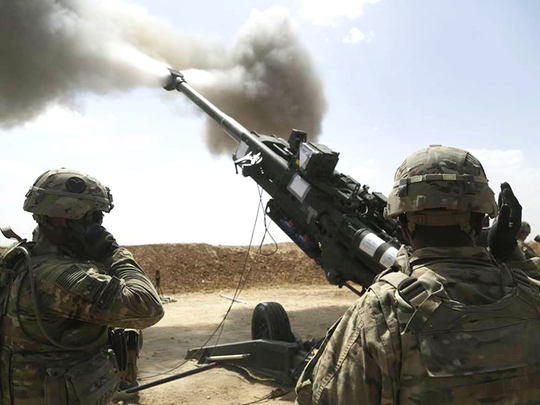
In barely a generation, air power has shifted from indiscriminate to discriminating. Thanks to advances in precision guidance, American bombs and missiles now generally get to where they’re intended. But human or machine error, bad luck or faulty military math still lead to unforeseen civilian deaths. And as the United States and its allies continue their bombing campaign against Daesh (the self-proclaimed Islamic State of Iraq and the Levant), many more noncombatants are perishing than they seem prepared to admit.
During last month, the number of reported civilian casualties from coalition air strikes reached the highest level since the air war began in August 2014. On July 19, 78 or more civilians were reported killed near the Daesh-occupied city of Manbij in Syria — many of them women and children. In the successful battle for Manbij alone, at least 200 civilians were reportedly killed.
The US and its allies have taken care to mitigate harm to civilians and the United States Central Command (Centcom) is investigating the July 19 incident. But with the fight moving deeper into the towns and cities of Iraq and Syria — where millions remain under Daesh’s thumb — the risk is rising. Denmark, a member of the coalition, recently warned that civilian deaths might be “unavoidable” in this new phase of the war. Yet, the allies appear poorly equipped to properly assess the numbers already being killed.
Airwars, the organisation I lead, at present estimates that at least 1,500 civilians have been killed by the US-led coalition — around one death for every nine strikes. Similar or higher tallies are reported by other monitoring groups, such as Iraq Body Count and the Syrian Observatory for Human Rights. But coalition officials have publicly admitted only 55 deaths. At a Pentagon briefing in April, Major General Peter Gersten dismissed as “propaganda” significant assertions to the contrary, telling reporters he had “a high level of confidence” in official casualty investigations. Can the coalition’s assessments really miss 95 per cent of fatalities in Iraq and Syria?
It may just be a matter of looking. “Our policy is not to go out and seek” allegations of civilian casualties, a senior official from Centcom, which oversees the bombing campaign, told me recently when I asked about the discrepancy between reports of noncombatant deaths and official investigations.
The coalition also appears to be in a hurry. It took about 15 months into the war for any admission of civilian deaths in Iraq — despite thousands of air strikes and more than 130 reported incidents. An average of 173 days still passes between a civilian casualty in Iraq or Syria and any public admission of responsibility.
There’s also the issue of how the coalition investigates civilian deaths. An official Centcom document declassified last year shows that investigators dismissed many allegations almost immediately. For example, after a member of Iraq’s parliament warned in January 2015 that internally displaced civilians had been killed by air strikes near Mosul, the coalition dismissed the report the following day, noting that there was “insufficient information to determine time and location of the incident”. Yet, the Iraqi lawmaker who issued the warning told my organisation that his office was never contacted for more information.
In the few cases in which the US has admitted causing civilian casualties, the military’s own assessments were crucial. Pilots, operators and analysts have come forward to declare possible problems and aerial footage and other intelligence data have then been scrutinised for errors. This self-examination can have real value. But the problem is that the coalition relies almost exclusively on these assessments, while ignoring most credible reports from the ground.
The United Nations Assistance Mission in Afghanistan has reported that 222 civilians died in international air strikes (mostly American) in 2013 and 2014, a period in which the US conducted 2,543 air strikes. Official White House data on counter-terrorism actions in Pakistan, Yemen and elsewhere show civilians dying on an average once every seven air strikes. This is the reality of precision warfare. Yet, we are simultaneously asked to accept that civilians are about 35 times less likely to die in the campaign against Daesh — a war that has so far seen 50,000 bombs and missiles loosened mainly on the cities and towns of Iraq and Syria.
US President Barack Obama’s recent executive order on civilian casualties calls on the Pentagon and the intelligence community to make better use of external monitors — and to consult with foreign partners on how to reduce the risk to noncombatants. Both would bring welcome benefits. An independent assessment of whether Centcom’s casualty-tracking programme is fit for purpose is also needed.
In the meantime, the Pentagon is not alone in its accounting failures. Russia still denies the more than 2,000 deaths it has most likely caused in Syria, while all 12 of America’s coalition partners insist they have killed only “bad guys”, This then is a systemic problem, one that suggests militaries are at present unfit — or unwilling — to count the dead accurately from above. From the air, all seems perfection. On the ground, civilians die.
— New York Times News Service
Chris Woods, author of Sudden Justice: America’s Secret Drone Wars (Oxford University Press, 2015), is a London-based investigative reporter.









